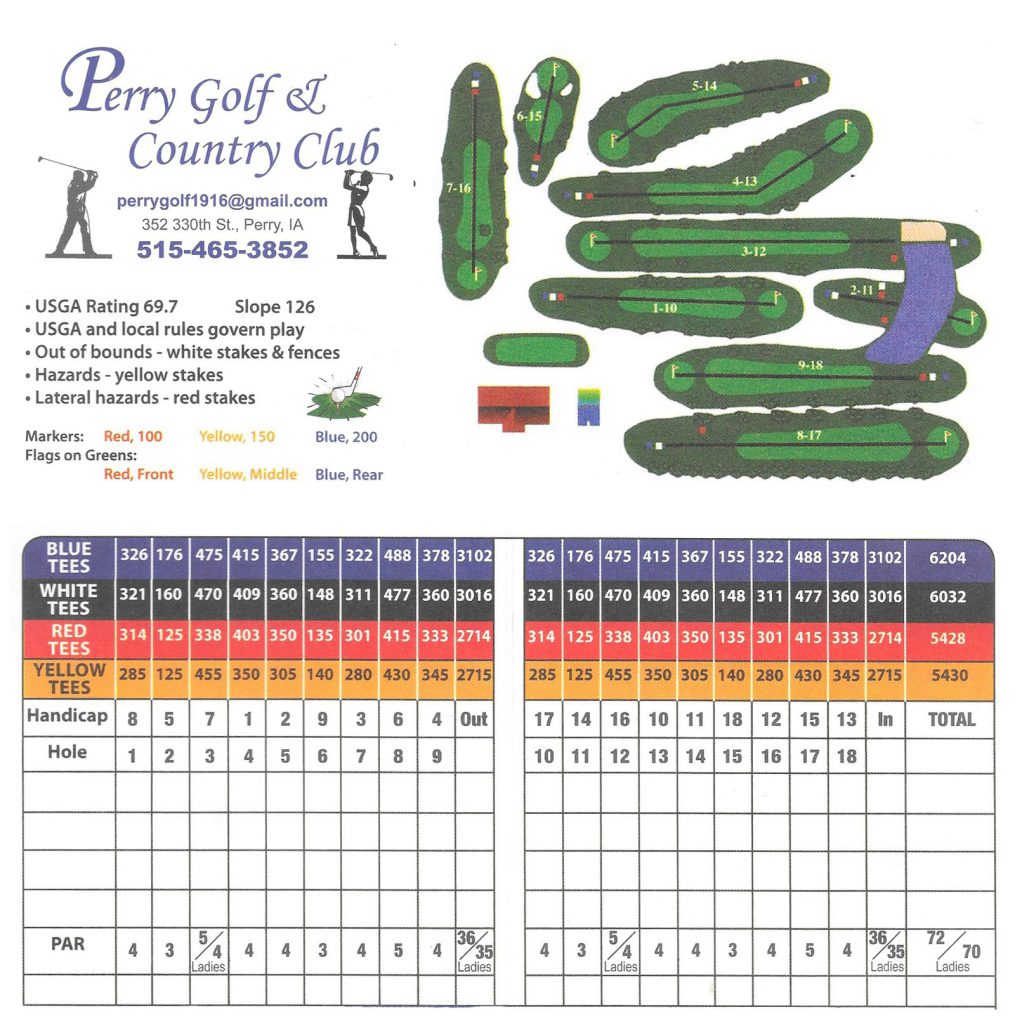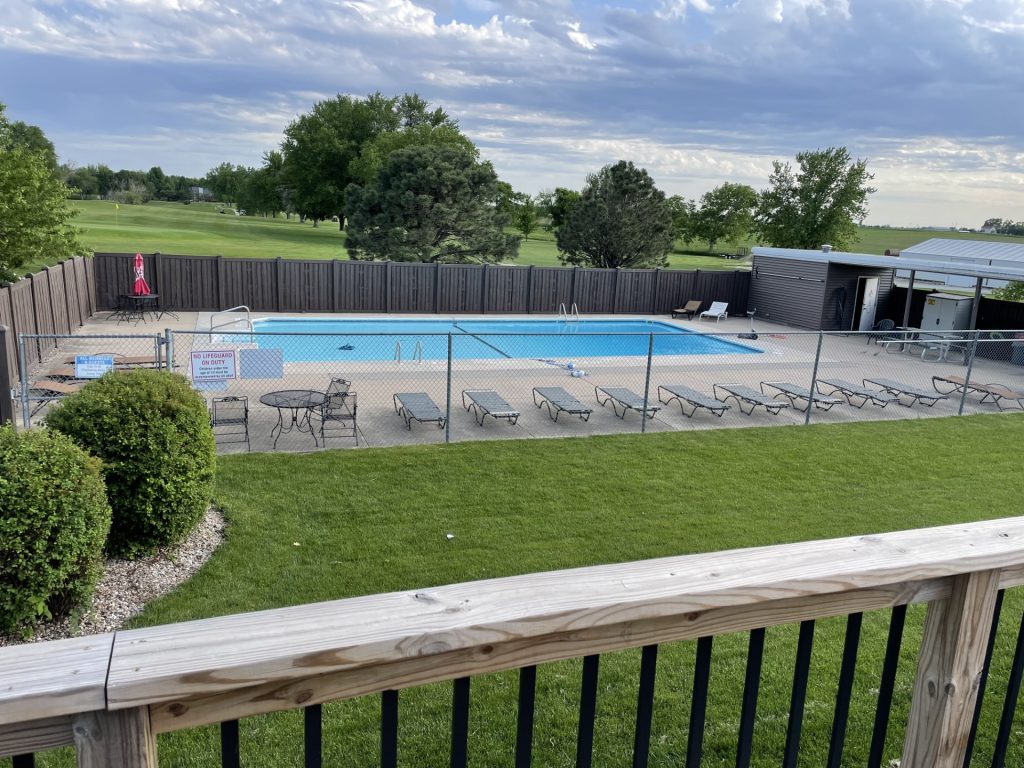The Course

Green Fees:
- 9 Holes – $20 per Golfer
- 18 Holes – $36 per Golfer
Cart Rental:
- 9 Holes – $12 per Golfer
- 18 Holes – $18 per Golfer
Leagues:
Ladies and Men’s leagues typically run from the first week of May to the end of August. The course is closed to non-league players during these times.
- Senior Men’s league: Tuesday Noon to 3:00
- Tuesday men’s League: 3:00 to 6:30
- Ladies league: Wednesday: 3:00 – 6:30
- Thursday Men’s League: 3:00 to 6:30
Party Room
Available for weddings, graduation parties, reunions, etc. Contact the clubhouse for availability and details.

Pool

History
A Town Called Perry
Midwest Life in Small-town Iowa
By Marjorie Patterson
Country Club (1916)
When Perry was young, certain of the population fell victim to golf fever. This was a very popular sport in many cities and some of the local citizenry had indulged in the game in other places. They exposed their friends and neighbors to this fever.
There was no way at the time to promote a clubhouse and properly prepared links, but there was a suitable meadow just south of town. Arrangements were made with the owner, W.W. Phillips, for use of the field. For a number of years the ground was used rent free. Any nice afternoon, young and old, men and women, could be seen hunting the illusive golf ball and taking off surplus flesh chasing it up and down the hills.
Then the time came for this particular field to be planted to corn, which meant the end of golfing there. When it appeared the golfers were about to lose their sport, a movement to lease grounds was begun. The long-talked of and much-wanted golf links became a reality in 1916. About twenty-five Perry men – all enthusiastic concerning the organization of a country club – met February 10, in the superior courtroom and decided to form an association, build a clubhouse and equip the grounds for golf and tennis.
At the meeting, the plan was so favorably received that it was decided to elect temporary officers: John Rude was president; H.C. Modlin, secretary. Directors were: H.M. Pattee; E.D. Carter; John Carmody; H.A. Modlin; and John R. Rude. Scott Snyder, H.A. Nash and Clark Brown were on the building committee.
The board purchased forty acres of land from A.D. Moore, north of the city, adjoining Chrystal Springs and Park, the property of E.D. Carter. The site was accessible by gravel road year round. M.G. Lyon, manager of the Iowa Railway and Light Company, thought it could be arranged for a line to carry light to the club site. This would also be important to farmers living along the line.
A golf expert, Warren Dickinson, was brought to town in March to look over the site. Dickinson became enthusiastic as soon as he stepped from the automobile onto the grounds. The only piece of poor road between the city and the proposed club was the lane east from Coleman Corner, a distance of about a quarter mile. It was decided to gravel this stretch.
As might be expected, volunteer labor was called upon and there came a morning when some of the club members were seen in town walking as though there wasn’t a joint in their entire anatomy. Then it was known for sure who had been helping make the gravel road.
When the 6 p.m. whistle sounded that first day, 130 loads of gravel had been hauled from the pit on the Bell farm just north of Beaver Creek bridge and dumped onto the road. Those 130 loads were hoisted into the wagon a shovelful at a time by men who had not performed a similar hard day’s work in years. The brightest spot came about 3 p.m., when Mrs. Amos Case arrived on the scene with a huge basket of egg sandwiches and hot coffee. At quitting time, the road was only half done.
There were nine teams on the job on the morning of March 27, thirteen that afternoon. The second day found only half a dozen or so club members on the job. The memory of the previous day’s strenuous work was too vivid to permit a return to the back-breaking, muscle-aching labor. Those men replaced themselves with paid shovelers and, on this day, 139 loads were added.
Hard physical labor did not end with the completion of the lane. A rock-clearing squad was organized and all members spent some time gathering and loading rocks which were hauled by teams to place near the clubhouse site. These were to be used in the construction of a cobblestone fireplace in the big main room on the first floor. Next, a three-ton steamroller was shipped to Perry and every foot of the 40 acres was rolled and smoothed.
By May 1916 the budding golf enthusiasts were playing on the new grounds. On May 3, the building committee closed a deal with Pearson and Son for the erection of a clubhouse. It was a two-story structure with a basement, modern in every way, with water, sewer and lighting systems.
The club was formally opened on July 10, and the fine new building and grounds were turned over to the members. An orchestra was hired and from 6 p.m. until midnight, the members and guests enjoyed a dancing party or card games at the clubhouse. The links were in excellent condition and the tennis courts were the finest in the community. Shade was plentiful and there were many places for the children to play.
The clubhouse was burned to the ground on October 22, 1923, shortly after 2 a.m. Along with the building went all the furniture and fixtures, the household goods of custodians Mr. and Mrs. Ed Mayo and considerable personal property owned by the members. This setback did not cool the enthusiasm. On February 21, 1924, the directors announced a new and better clubhouse would be built as soon as weather conditions would permit. And so the club, with increased membership, went on.
